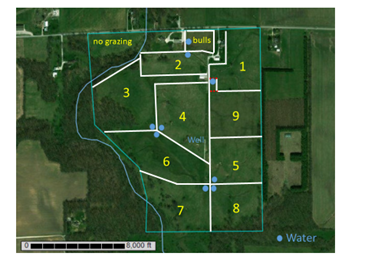What does the word “stockpile” mean to you? Our understanding of the meaning is to “store away for future use.” A few years ago, because of Covid-19, some families were stockpiling toilet paper. Some may have thought that the most-right word was hoarding! Within forage-livestock agriculture, the word stockpiling refers to growing forage in the pasture that can be used at a later time.

Rotational grazing a pasture permits stockpiling forage for grazing in the late fall and early winter. (Photo Credit: Keith Johnson)
A properly managed rotational stocking system allows this to happen. Approximately, one-fourth of the acreage can be restricted from the livestock so forage can grow to be grazed in the late fall and possibly the early winter; As forage growth occurs in these paddocks (sometimes called cells), other forage in the remaining paddocks is being grazed in the late summer and early fall. Addition of around 50 pounds of actual nitrogen per acre in late August can stimulate much cool-season grass growth, especially tall fescue, if rainfall occurs. If it fits the rotation, use paddocks with the most contribution from tall fescue to stockpile growth. Pastures with at least 30 percent of the dry matter yield being legumes will not receive as much benefit from the addition of nitrogen and is probably not an advised expense. If a soil test has recently been done or is done pronto, other recommended nutrients can be blended with the nitrogen and applied, too.



